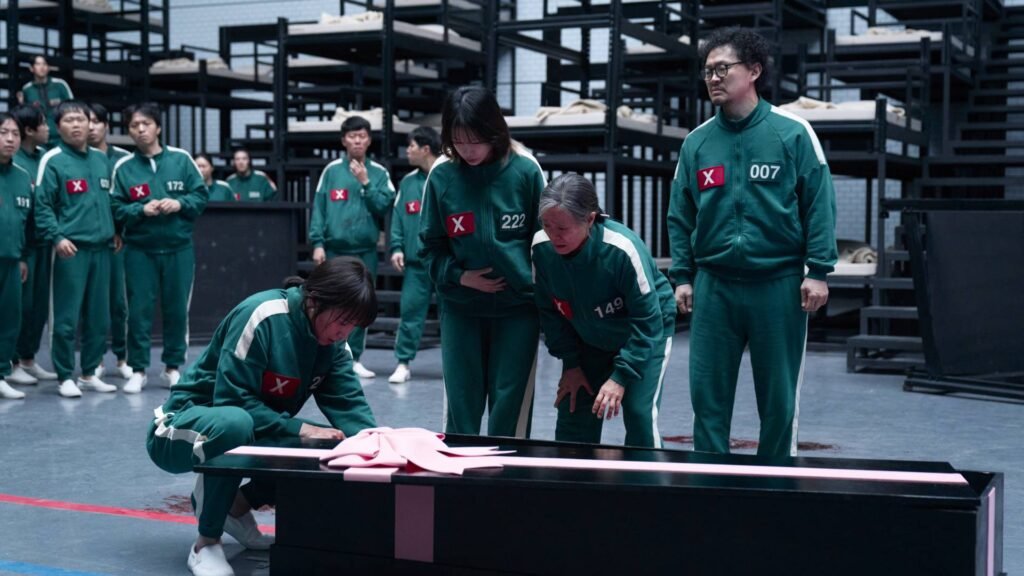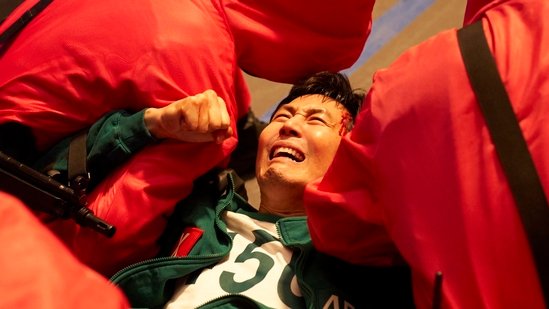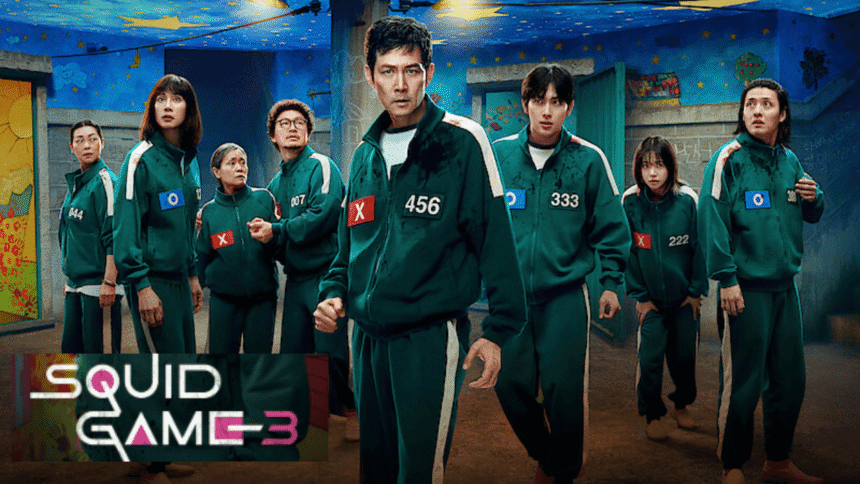The long-awaited squid games season 3 release arrives on 27 June 2025 at 12 :30 p.m. IST, and global anticipation could not be higher. Industry reports confirm that all six episodes drop at once, ending months of speculation about schedules. Viewers have cleared calendars, planned watch parties, and vowed to dodge spoilers for the franchise’s bold final chapter.
A trilogy’s crowning chapter
The creator mapped this concluding act in early 2023 and spent a full year refining scripts while scouting darker, more oppressive locations. Each episode was treated like a stand-alone feature, resulting in six hour-long mini-movies stitched into an intense binge. That ambition drove costs upward but delivered bigger sets, sharper stunt work, and practical effects that eclipse everything seen so far.
Familiar faces, new motives

Lee Jung-jae returns as Seong Gi-hun, leaner and colder than the timid player we first met. Wi Ha-joon reprises Detective Jun-ho, now determined to expose every layer of the game’s hierarchy. Gong Yoo’s enigmatic recruiter stalks bustling plazas, turning chance encounters into ominous invitations. Flashbacks also pull departed characters back into focus, adding emotional depth without cheap resurrection.
Deadlier games, doubled prize
Game designers spent ten months building full-scale mock-ups inside warehouses. One challenge suspends a rotating glass cylinder fifty metres above ground, fusing tug-of-war with vertigo-inducing heights. Another twists marbles into a duel against AI-controlled projectiles that change tactics mid-round, forcing players to improvise on instinct. The two-part finale unfolds on wind-scoured coastal cliffs, where contestants scale a rig bolted into sheer stone while sandstorms whip the arena. Producers raised the prize fund to ₩92 billion, intensifying debates each time players weigh quitting.
Shocking cameos spark feverish theories

Three secret guests appear for brief but pivotal moments. A global sports legend shot a rain-soaked sequence that showcases surprising acting chops. A renowned martial-arts veteran brings authenticity to a dance-like elimination game requiring split-second timing. The final cameo belongs to an award-winning performer who enters as a masked game master and trades a chilling stare with the Front Man, hinting that the cycle may never end.
Inside production: practical sets over pixels
Instead of leaning on digital trickery, artisans built environments at full scale. A life-size subway station replica was flooded waist-deep for a tense nighttime escape scene. Technicians embedded LED tiles behind dormitory walls; the lights pulse to each player’s recorded heartbeat, making fear almost visible. Costume teams hid QR-patterned stitching inside tracksuits, rewarding sharp-eyed viewers with augmented-reality dossiers that unlock once the season finishes.
Marketing blitz without borders
Iconic geometric symbols towered over twenty-two capital skylines as three-storey billboards. A six-metre animatronic doll toured shopping centres, pausing mid-turn to shout the release date and startle crowds. Social channels rolled out daily cryptic posters, each revealing one Korean consonant; fans combined screenshots to spell the season’s final slogan in under an hour.
Fan theories hit overdrive
Online discussion boards dissect every trailer frame for clues. One leading theory argues that shoelace colours foreshadow survival odds because they match dormitory bunks reserved for finalists in season one. Another claims each new game mirrors one of the seven deadly sins, culminating in a moral face-off where players determine each other’s fates.
Sound and score push physical limits
Composer Jung Jae-il recorded a sixty-piece string section inside an aircraft hangar to capture cavernous reverb. Bass frequencies dip to 40 Hz during scenes synced to on-screen heartbeats; home-theatre owners can expect walls to shake. Traditional playground chants weave through atonal synth bursts, reminding audiences that innocent nostalgia has morphed into pure menace.
Costume evolution and hidden symbolism
Tracksuits shift to a deeper teal, symbolising the moral murk swallowing returning players. Guard masks now sport mirrored visors, forcing contestants to stare at their own panic. VIP robes add subtle animal prints, cueing viewers to fresh predators in the social order. Under each sleeve cuff lies a scannable symbol plucked from ancient folklore, connecting brutal contests to Korea’s mythic past.
Safety first in a world of cinematic danger
Stunt coordinators drilled the cast in harness protocol every morning before height-based scenes. A dedicated trauma-counselling unit taught breathing exercises that help actors shed residual stress after gruelling takes. Production enforced no-phone zones on arena sets, locking devices in pouches until the day wrapped to prevent leaks.
Early critics praise “inventive brutality”
Advance screeners drew a 90 percent approval rating from reviewers who applauded lean pacing and emotional heft. One mid-season duel, staged on transparent glass panels above a dry ice cloud, already ranks among the show’s most inventive set pieces. Critics also hailed Lee Jung-jae’s ability to transform grief into steely resolve and noted that the finale’s cliff sequence rivals classic war epics for scale. gamesradar.com
Why the finale matters for global drama
The squid games season 3 release serves as a litmus test for high-concept storytelling outside English-language markets. Success will encourage executives to finance daring narratives from Seoul, São Paulo, and beyond. Viewer data on binge completion, rewatch spikes, and social-media sentiment will influence which ambitious projects get the green light next.
you may also like: The Simpsons Marge Death Shocks Fans in Season 36 Flash-Forward
Release-day survival kit
- Block six hours. Average episodes run 58 minutes; the finale stretches to 72.
- Mute push alerts. Major plot twists should remain unspoiled until you finish.
- Crank the volume. Low-frequency cues add physical heft to certain games.
- Keep tissues nearby. Cast members hint at a farewell that rivals the marble heartbreak.
- Hydrate often. Adrenaline spikes drain energy during marathon viewing.
Frequently asked questions
Does season 3 truly end the saga?
Yes. The creator always envisioned Gi-hun’s journey as three acts. While spin-offs remain possible, this particular story closes here.
How many contestants start round one?
A lean roster of one hundred players enters, allowing deeper focus on each elimination’s ripple effect.
Are the games still based on children’s pastimes?
Mostly. Each innocent activity gains a lethal twist, yet every round remains recognisable to anyone who grew up with Korean playground culture.
Will there be more dialogue in languages other than Korean?
Yes. VIP scenes and at least one contest involve multilingual participants, expanding the show’s linguistic reach without sacrificing its core identity.
Closing thoughts: brace for impact
Everything signals that the squid games season 3 release will outdo its own legend. Bigger sets, bolder storytelling, and a fearless cast merge into six blistering hours of television. Viewers will face questions about loyalty, desperation, and the true price of spectacle long after credits roll. When the dust settles, one fact endures: in this universe, victory often costs more than defeat—yet hope still flickers even within a game built on despair.
Clear your schedule, dim the lights, and step back into the arena. The final countdown has begun.

